Answered step by step
Verified Expert Solution
Question
1 Approved Answer
Here is chapter 24 from the book, explain with graphs please For number 3 I attached the screenshot of book chapter the rest is typical
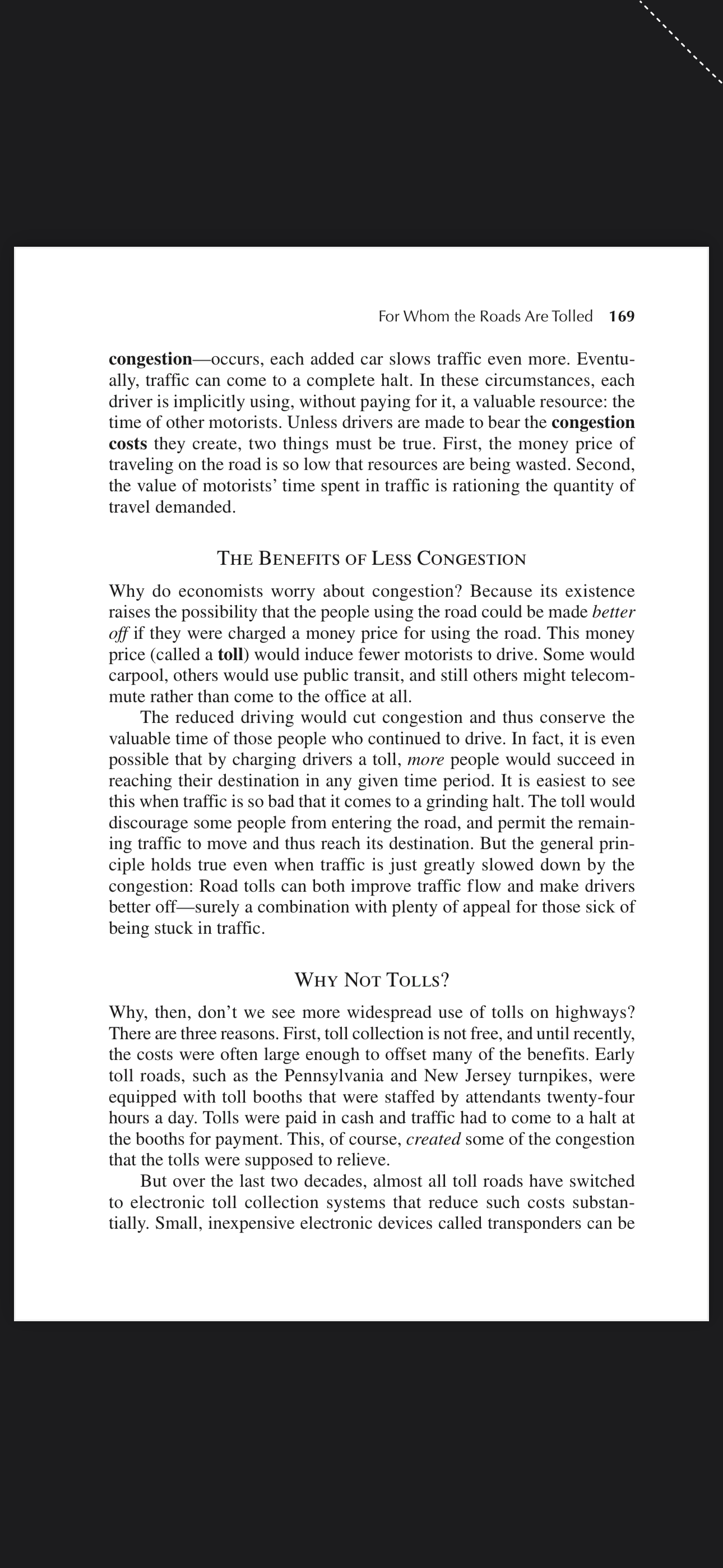

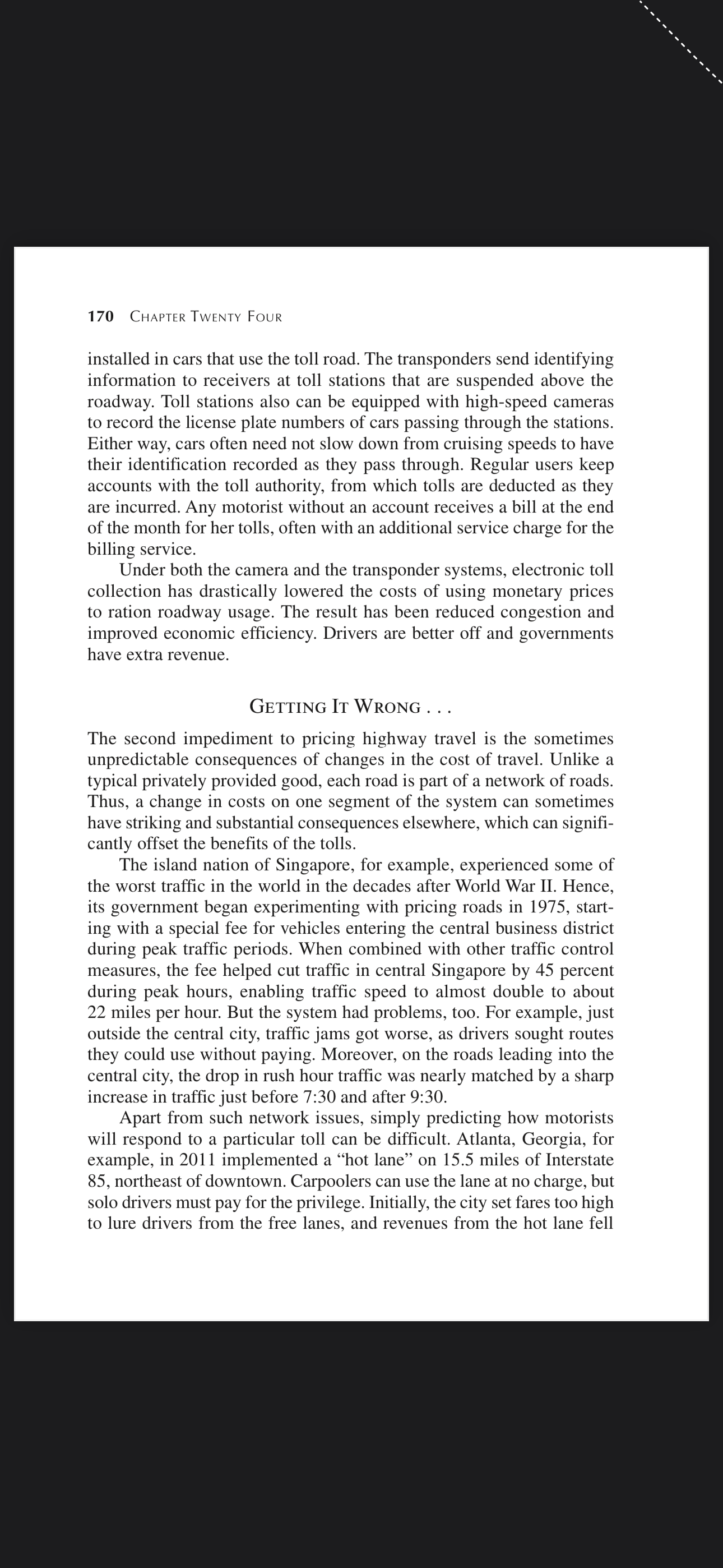
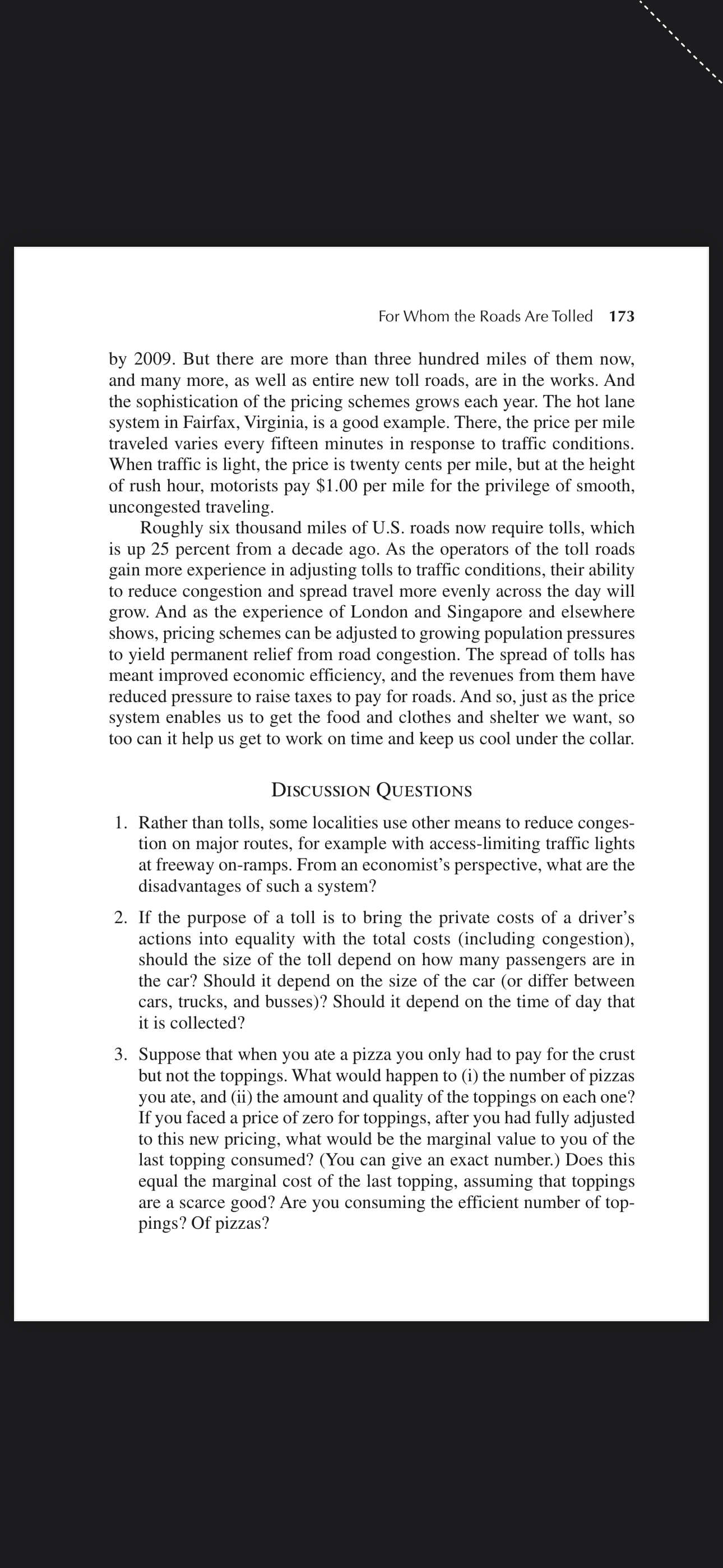
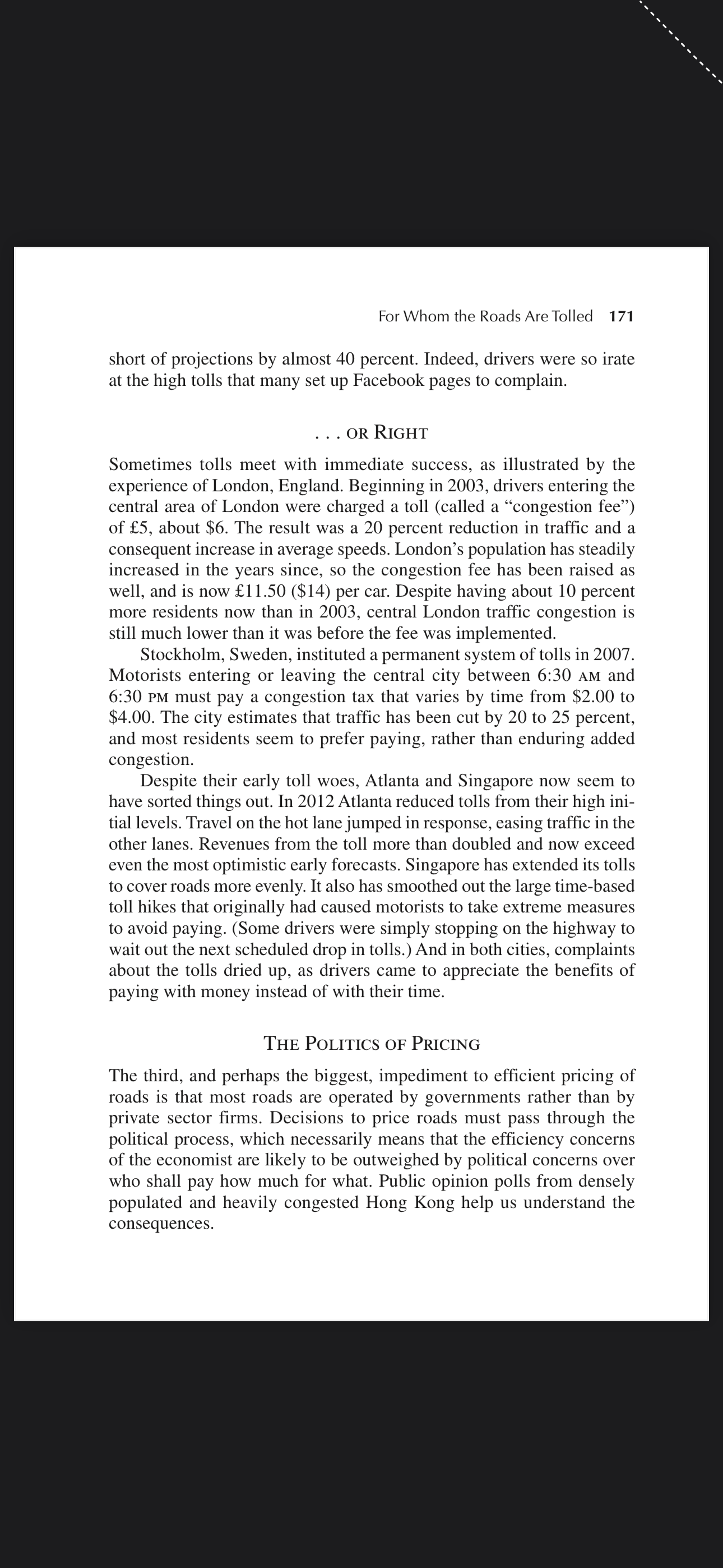

Here is chapter 24 from the book, explain with graphs please
For number 3 I attached the screenshot of book chapter the rest is typical eco question

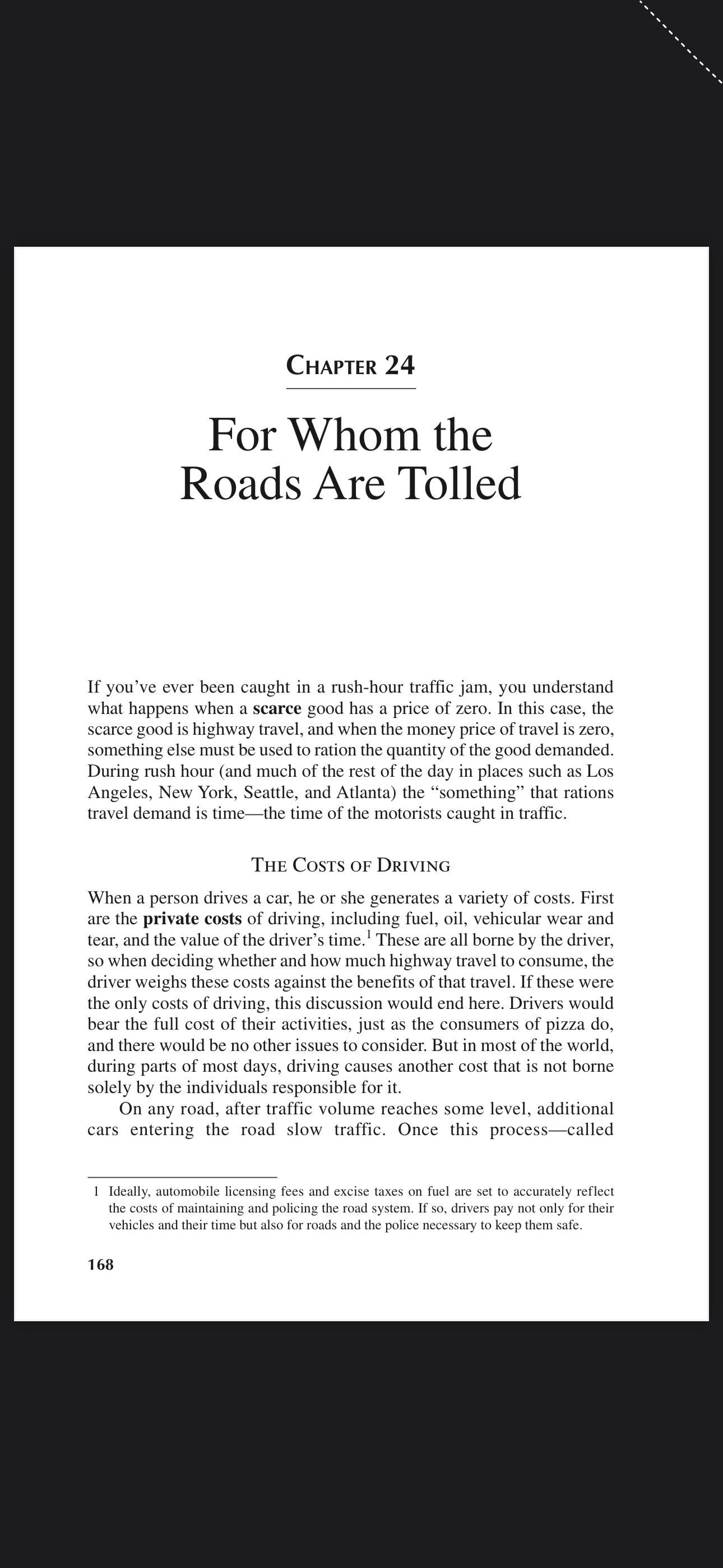
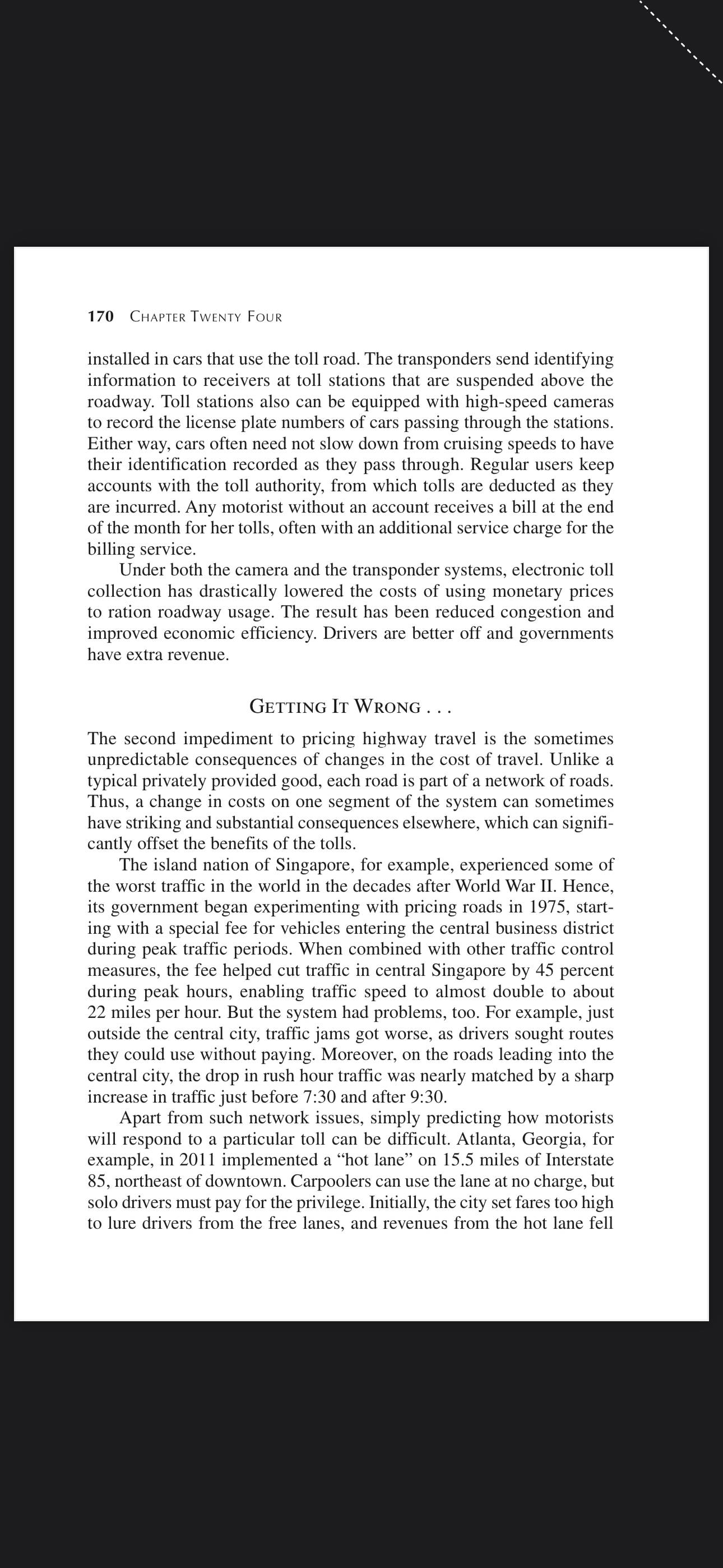
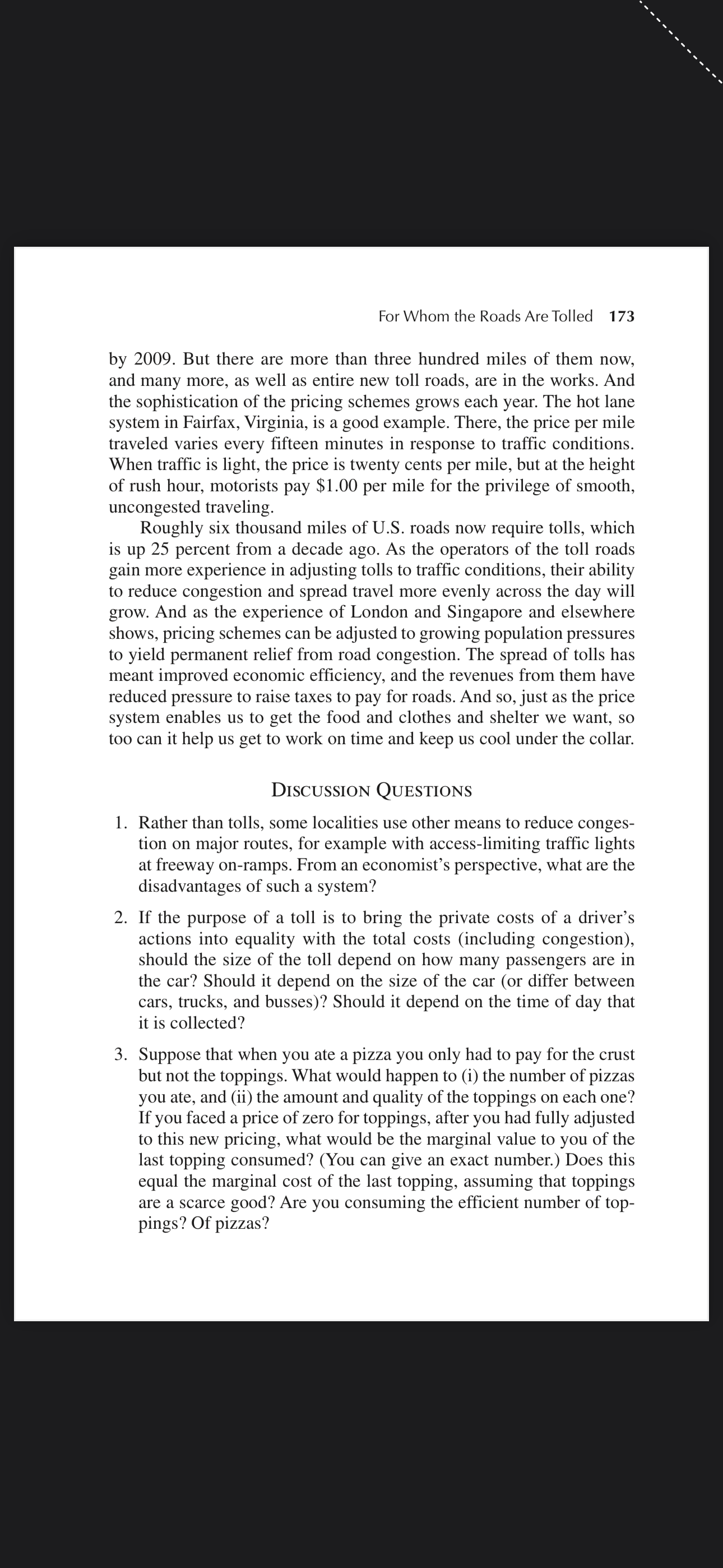
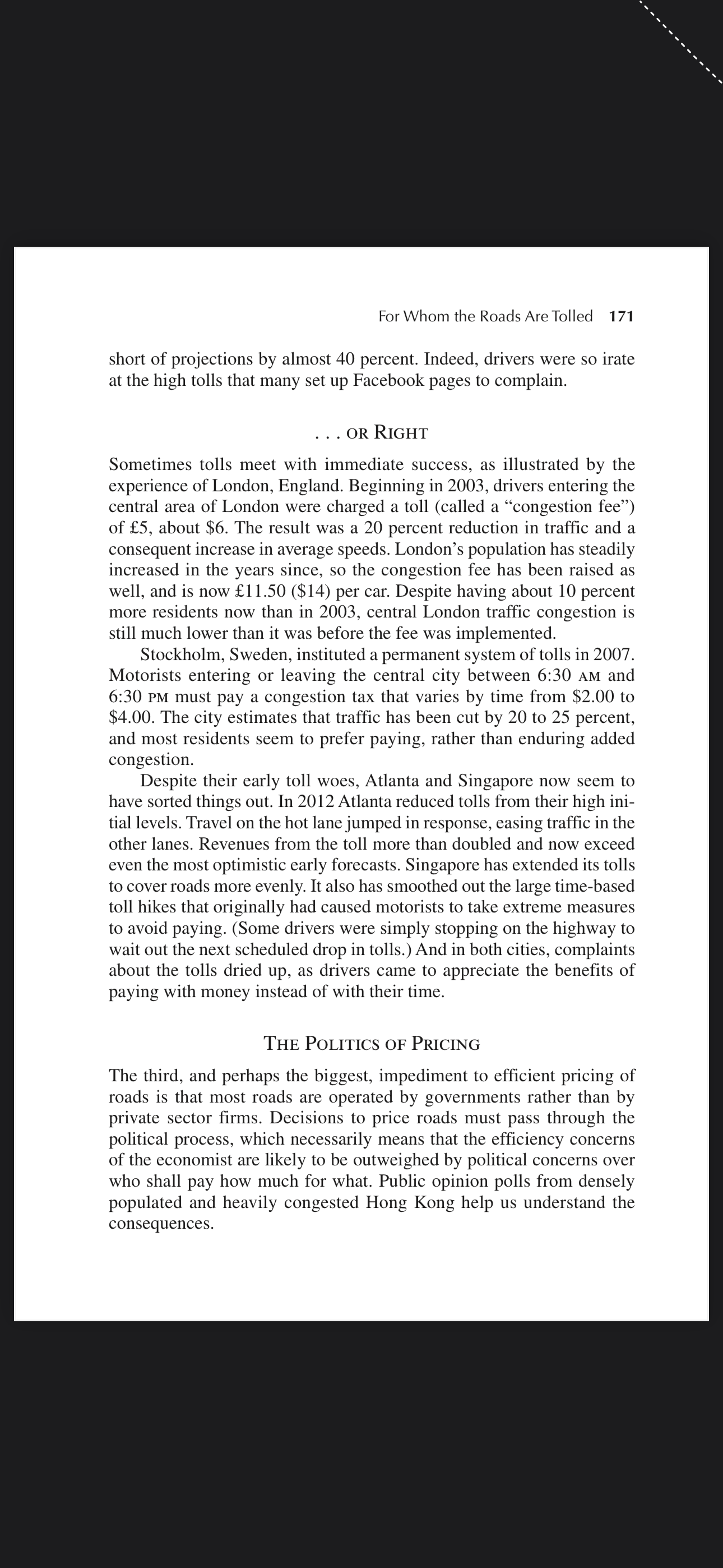
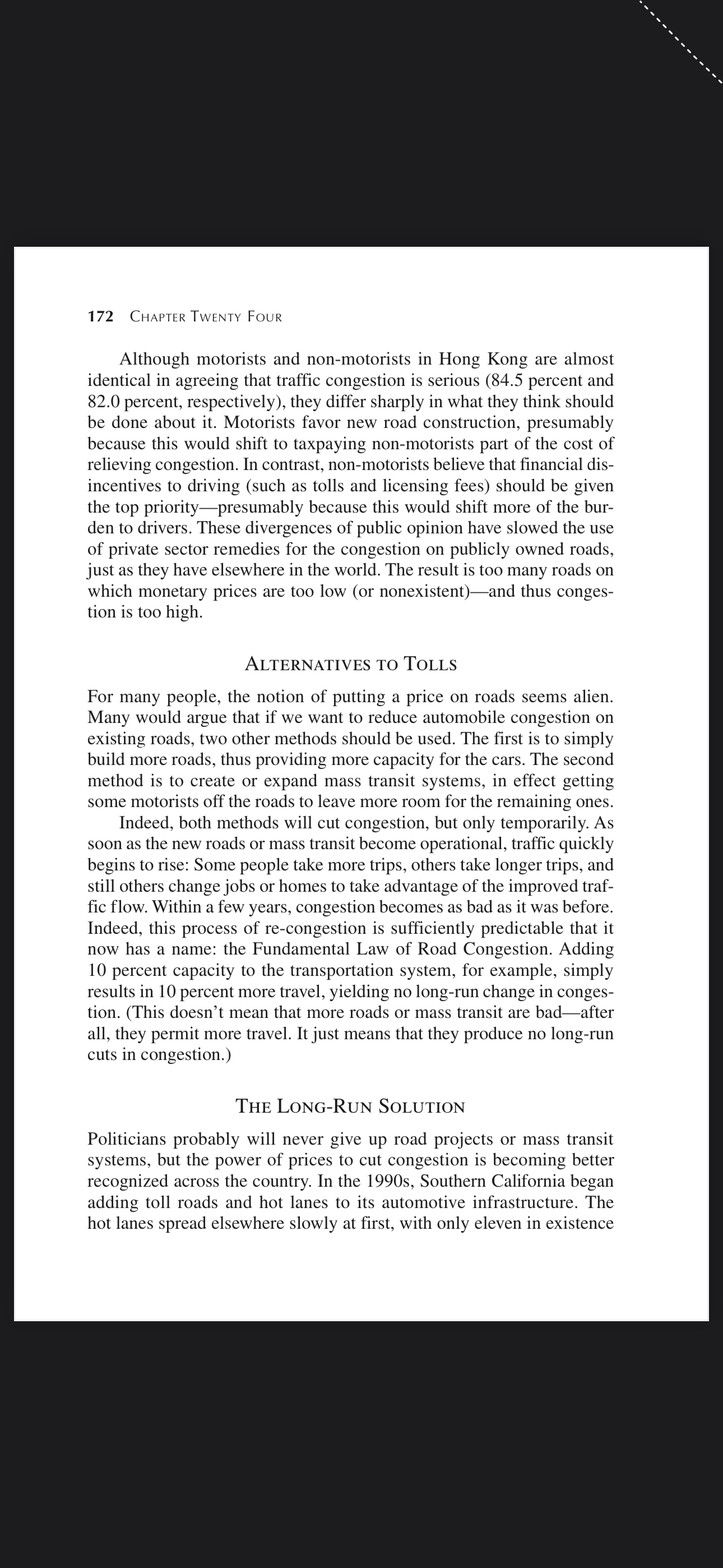 For Whom the Roads Are Tolled 169 congestionioccurs, each added car slows trafc even more. Eventu- ally, trafc can come to a complete halt. In these circumstances, each driver is implicitly using, without paying for it, a valuable resource: the time of other motorists Unless drivers are made to bear the congestion costs they create, two things must be true. First, the money price of traveling on the road is so low that resources are being wasted. Second, the value of motorists\" time spent in trafc is rationing the quantity of travel demanded. THE BENEFITS OF LEss CONGESTION Why do economists worry about congestion? Because its existence raises the possibility that the people using the road could be made bang/r of)" if they were charged a money price for using the road. This money price (called a toll) would induce fewer motorists to drive. Some would carpool, others would use public transit, and still others might telecom- mute rather than come to the ofce at all. The reduced driving would cut congestion and thus conserve the valuable time of those people who continued to drive. In fact, it is even possible that by charging drivers a toll, more people would succeed in reaching their destination in any given time period. It is easiest to see this when traffic is so bad that it comes to a grinding halt. The toll would discourage some people from entering the road, and permit the remain ing trafc to move and thus reach its destination. But the general prin ciple holds true even when trafc is just greatly slowed down by the congestion: Road tolls can both improve trafc flow and make drivers better offisurely a combination with plenty of appeal for those sick of being stuck in trafc. WHY NOT TOLLs? Why, then, don't we see more widespread use of tolls on highways? There are three reasons. First, toll collection is not free, and until recently, the costs were often large enough to offset many of the benefits. Early toll roads, such as the Pennsylvania and New Jersey turnpikes, were equipped with toll booths that were staffed by attendants twenty-four hours a day. Tolls were paid in cash and trafc had to come to a halt at the booths for payment. This, of course, created some of the congestion that the tolls were supposed to relieve. But over the last two decades, almost all toll roads have switched to electronic toll collection systems that reduce such costs substan tially. Small, inexpensive electronic devices called transponders can be CHAPTER 24 For Whom the Roads Are Tolled If you've ever been caught in a rush-hour trafc jam, you understand what happens when a scarce good has a price of zero. In this case, the scarce good is highway travel, and when the money price of travel is zero, something else must be used to ration the quantity of the good demanded During rush hour (and much of the rest of the day in places such as Los Angeles, New York, Seattle, and Atlanta) the \"something\" that rations travel demand is timeithe time of the motorists caught in trafc. THE COSTS OF DRIVING When a person drives a car. he or she generates a variety of costs. First are the private costs of driving, including fuel, oil, vehicular wear and tear, and the value of the driver's time.l These are all borne by the driver, so when deciding whether and how much highway travel to consume, the driver weighs these costs against the benets of that travel. If these were the only costs of driving. this discussion would end here. Drivers would hear the full cost of their activities, just as the consumers of pizza do. and there would be no other issues to consider. But in most of the world. during parts of most days, driving causes another cost that is not borne solely by the individuals responsible for it. On any road, after traffic volume reaches some level, additional cars entering the road slow traffic. Once this processicalled l Ideally, automobile licensing fees and excise taxes on fuel are set to accurately reflect the costs of maintaining and policing the road system. If so, drivers pay not only for their vehicles and their time but also for roads and the police necessary to keep them safe. 168 170 CHAPTER TWLNTY FOUR installed in cars that use the toll road. The transponders send identifying information to receivers at toll stations that are suspended above the roadway. Toll stations also can be equipped with highspeed cameras to record the license plate numbers of cars passing through the stations. Either way, cars often need not slow down from cruising speeds to have their identification recorded as they pass through Regular users keep accounts with the toll authority, from which tolls are deducted as they are incurred. Any motorist without an account receives a bill at the end of the month for her tolls, often with an additional service charge for the billing service. Under both the camera and the transponder systems, electronic toll collection has drastically lowered the costs of using monetary prices to ration roadway usage. The result has been reduced congestion and improved economic efciency. Drivers are better off and governments have extra revenue. GETTING IT WRONG . . . The second impediment to pricing highway travel is the sometimes unpredictable consequences of changes in the cost of travel. Unlike a typical privately provided good, each road is part of a network of roads. Thus, a change in costs on one segment of the system can sometimes have striking and substantial consequences elsewhere, which can signi cantly offset the benefits of the tolls. The island nation of Singapore, for example, experienced some of the worst trafc in the world in the decades after World War II. Hence, its government began experimenting with pricing roads in 1975, start ing with a special fee for vehicles entering the central business district during peak trafc periods. When combined with other trafc control measures, the fee helped cut trafc in central Singapore by 45 percent during peak hours, enabling trafc speed to almost double to about 22 miles per hour. But the system had problems, too. For example, just outside the central city, trafc jams got worse, as drivers sought routes they could use without paying. Moreover, on the roads leading into the central city, the drop in rush hour trafc was nearly matched by a sharp increase in trafc just before 7:30 and after 9:30. Apart from such network issues, simply predicting how motorists will respond to a particular toll can be difcult. Atlanta, Georgia, for example, in 2011 implemented a \"hot lane\" on 15.5 miles of Interstate 85, northeast of downtown. Carpoolers can use the lane at no charge, but solo drivers must pay for the privilege. Initially, the city set fares too high to lure drivers from the free lanes, and revenues from the hot lane fell For Whom the Roads Are Tolled 173 by 2009. But there are more than three hundred miles of them now, and many more, as well as entire new toll roads, are in the works. And the sophistication of the pricing schemes grows each year. The hot lane system in Fairfax, Virginia, is a good example There, the price per mile traveled varies every fteen minutes in response to traffic conditions. When trafc is light, the price is twenty cents per mile, but at the height of rush hour, motorists pay $1.00 per mile for the privilege of smooth, uncongested traveling. Roughly six thousand miles of U.S. roads now require tolls, which is up 25 percent from a decade ago. As the operators of the toll roads gain more experience in adjusting tolls to trafc conditions, their ability to reduce congestion and spread travel more evenly across the day will grow. And as the experience of London and Singapore and elsewhere shows, pricing schemes can be adjusted to growing population pressures to yield permanent relief from road congestion. The spread of tolls has meant improved economic efciency, and the revenues from them have reduced pressure to raise taxes to pay for roads. And so, just as the price system enables us to get the food and clothes and shelter we want, so too can it help us get to work on time and keep us cool under the collar. DISCUSSION QUESTIONS 1. Rather than tolls, some localities use other means to reduce conges tion on major routes, for example with accesslimiting trafc lights at freeway onramps. From an economist's perspective, what are the disadvantages of such a system? . If the purpose of a toll is to bring the private costs of a driver's actions into equality with the total costs (including congestion), should the size of the toll depend on how many passengers are in the car? Should it depend on the size of the car (or differ between cars, trucks, and busses)? Should it depend on the time of day that it is collected? . Suppose that when you ate a pizza you only had to pay for the crust but not the toppings. What would happen to (i) the number of pizzas you ate, and (ii) the amount and quality of the toppings on each one? If you faced a price of zero for toppings, after you had fully adjusted to this new pricing, what would be the marginal value to you of the last topping consumed? (You can give an exact number.) Does this equal the marginal cost of the last topping, assuming that toppings are a scarce good? Are you consuming the efcient number of top pings? Of pizzas? For Whom the Roads Are Tolled 171 short of projections by almost 40 percent. Indeed, drivers were so irate at the high tolls that many set up Facebook pages to complain. . . . OR RIGHT Sometimes tolls meet with immediate success, as illustrated by the experience of London, England. Beginning in 2003, drivers entering the central area of London were charged a toll (called a \"congestion fee\") of 5, about $6. The result was a 20 percent reduction in traffic and a consequent increase in average speeds. London's population has steadily increased in the years since, so the congestion fee has been raised as well, and is now 11.50 ($14) per car. Despite having about 10 percent more residents now than in 2003, central London traffic congestion is still much lower than it was before the fee was implemented. Stockholm, Sweden, instituted a permanent system of tolls in 2007. Motorists entering or leaving the central city between 6:30 AM and 6:30 PM must pay a congestion tax that varies by time from $2.00 to $4.00. The city estimates that trafc has been cut by 20 to 25 percent, and most residents seem to prefer paying, rather than enduring added congestion. Despite their early toll woes, Atlanta and Singapore now seem to have sorted things out. In 2012 Atlanta reduced tolls from their high ini tial levels. Travel on the hot lane jumped in response, easing trafc in the other lanes. Revenues from the toll more than doubled and now exceed even the most optimistic early forecasts. Singapore has extended its tolls to cover roads more evenly. It also has smoothed out the large timebased toll hikes that originally had caused motorists to take extreme measures to avoid paying. (Some drivers were simply stopping on the highway to wait out the next scheduled drop in tolls.) And in both cities, complaints about the tolls dried up, as drivers came to appreciate the benets of paying with money instead of with their time. THE POLITICS OF PRICING The third, and perhaps the biggest, impediment to efficient pricing of roads is that most roads are operated by governments rather than by private sector firms. Decisions to price roads must pass through the political process, which necessarily means that the efficiency concerns of the economist are likely to be outweighed by political concerns over who shall pay how much for what. Public opinion polls from densely populated and heavily congested Hong Kong help us understand the consequences. 172 CHAPTER TWLNTY FOUR Although motorists and non-motorists in Hong Kong are almost identical in agreeing that trafc congestion is serious (84.5 percent and 82.0 percent, respectively), they differ sharply in what they think should be done about it. Motorists favor new road construction, presumably because this would shift to taxpaying nonmotorists part of the cost of relieving congestion. In contrast, non-motorists believe that nancial dis- incentives to driving (such as tolls and licensing fees) should be given the top priorityipresumably because this would shift more of the bur den to drivers. These divergences of public opinion have slowed the use of private sector remedies for the congestion on publicly owned roads, just as they have elsewhere in the world. The result is too many roads on which monetary prices are too low (or nonexistent)iand thus conges tion is too high. ALTERNATIVES TO TOLLs For many people, the notion of putting a price on roads seems alien. Many would argue that if we want to reduce automobile congestion on existing roads, two other methods should be used. The rst is to simply build more roads, thus providing more capacity for the cars. The second method is to create or expand mass transit systems, in effect getting some motorists off the roads to leave more room for the remaining ones. Indeed, both methods will cut congestion, but only temporarily. As soon as the new roads or mass transit become operational, trafc quickly begins to rise: Some people take more trips, others take longer trips, and still others change jobs or homes to take advantage of the improved traf- c flow. Within a few years, congestion becomes as bad as it was before. Indeed, this process of recongestion is sufciently predictable that it now has a name: the Fundamental Law of Road Congestion. Adding 10 percent capacity to the transportation system, for example, simply results in 10 percent more travel, yielding no long-run change in conges- tion. (This doesn't mean that more roads or mass transit are badiafter all, they permit more travel. It just means that they produce no longrun cuts in congestion.) THE LONG-RUN SOLUTION Politicians probably will never give up road projects or mass transit systems, but the power of prices to cut congestion is becoming better recognized across the country. In the 19905, Southern California began adding toll roads and hot lanes to its automotive infrastructure. The hot lanes spread elsewhere slowly at first, with only eleven in existence
For Whom the Roads Are Tolled 169 congestionioccurs, each added car slows trafc even more. Eventu- ally, trafc can come to a complete halt. In these circumstances, each driver is implicitly using, without paying for it, a valuable resource: the time of other motorists Unless drivers are made to bear the congestion costs they create, two things must be true. First, the money price of traveling on the road is so low that resources are being wasted. Second, the value of motorists\" time spent in trafc is rationing the quantity of travel demanded. THE BENEFITS OF LEss CONGESTION Why do economists worry about congestion? Because its existence raises the possibility that the people using the road could be made bang/r of)" if they were charged a money price for using the road. This money price (called a toll) would induce fewer motorists to drive. Some would carpool, others would use public transit, and still others might telecom- mute rather than come to the ofce at all. The reduced driving would cut congestion and thus conserve the valuable time of those people who continued to drive. In fact, it is even possible that by charging drivers a toll, more people would succeed in reaching their destination in any given time period. It is easiest to see this when traffic is so bad that it comes to a grinding halt. The toll would discourage some people from entering the road, and permit the remain ing trafc to move and thus reach its destination. But the general prin ciple holds true even when trafc is just greatly slowed down by the congestion: Road tolls can both improve trafc flow and make drivers better offisurely a combination with plenty of appeal for those sick of being stuck in trafc. WHY NOT TOLLs? Why, then, don't we see more widespread use of tolls on highways? There are three reasons. First, toll collection is not free, and until recently, the costs were often large enough to offset many of the benefits. Early toll roads, such as the Pennsylvania and New Jersey turnpikes, were equipped with toll booths that were staffed by attendants twenty-four hours a day. Tolls were paid in cash and trafc had to come to a halt at the booths for payment. This, of course, created some of the congestion that the tolls were supposed to relieve. But over the last two decades, almost all toll roads have switched to electronic toll collection systems that reduce such costs substan tially. Small, inexpensive electronic devices called transponders can be CHAPTER 24 For Whom the Roads Are Tolled If you've ever been caught in a rush-hour trafc jam, you understand what happens when a scarce good has a price of zero. In this case, the scarce good is highway travel, and when the money price of travel is zero, something else must be used to ration the quantity of the good demanded During rush hour (and much of the rest of the day in places such as Los Angeles, New York, Seattle, and Atlanta) the \"something\" that rations travel demand is timeithe time of the motorists caught in trafc. THE COSTS OF DRIVING When a person drives a car. he or she generates a variety of costs. First are the private costs of driving, including fuel, oil, vehicular wear and tear, and the value of the driver's time.l These are all borne by the driver, so when deciding whether and how much highway travel to consume, the driver weighs these costs against the benets of that travel. If these were the only costs of driving. this discussion would end here. Drivers would hear the full cost of their activities, just as the consumers of pizza do. and there would be no other issues to consider. But in most of the world. during parts of most days, driving causes another cost that is not borne solely by the individuals responsible for it. On any road, after traffic volume reaches some level, additional cars entering the road slow traffic. Once this processicalled l Ideally, automobile licensing fees and excise taxes on fuel are set to accurately reflect the costs of maintaining and policing the road system. If so, drivers pay not only for their vehicles and their time but also for roads and the police necessary to keep them safe. 168 170 CHAPTER TWLNTY FOUR installed in cars that use the toll road. The transponders send identifying information to receivers at toll stations that are suspended above the roadway. Toll stations also can be equipped with highspeed cameras to record the license plate numbers of cars passing through the stations. Either way, cars often need not slow down from cruising speeds to have their identification recorded as they pass through Regular users keep accounts with the toll authority, from which tolls are deducted as they are incurred. Any motorist without an account receives a bill at the end of the month for her tolls, often with an additional service charge for the billing service. Under both the camera and the transponder systems, electronic toll collection has drastically lowered the costs of using monetary prices to ration roadway usage. The result has been reduced congestion and improved economic efciency. Drivers are better off and governments have extra revenue. GETTING IT WRONG . . . The second impediment to pricing highway travel is the sometimes unpredictable consequences of changes in the cost of travel. Unlike a typical privately provided good, each road is part of a network of roads. Thus, a change in costs on one segment of the system can sometimes have striking and substantial consequences elsewhere, which can signi cantly offset the benefits of the tolls. The island nation of Singapore, for example, experienced some of the worst trafc in the world in the decades after World War II. Hence, its government began experimenting with pricing roads in 1975, start ing with a special fee for vehicles entering the central business district during peak trafc periods. When combined with other trafc control measures, the fee helped cut trafc in central Singapore by 45 percent during peak hours, enabling trafc speed to almost double to about 22 miles per hour. But the system had problems, too. For example, just outside the central city, trafc jams got worse, as drivers sought routes they could use without paying. Moreover, on the roads leading into the central city, the drop in rush hour trafc was nearly matched by a sharp increase in trafc just before 7:30 and after 9:30. Apart from such network issues, simply predicting how motorists will respond to a particular toll can be difcult. Atlanta, Georgia, for example, in 2011 implemented a \"hot lane\" on 15.5 miles of Interstate 85, northeast of downtown. Carpoolers can use the lane at no charge, but solo drivers must pay for the privilege. Initially, the city set fares too high to lure drivers from the free lanes, and revenues from the hot lane fell For Whom the Roads Are Tolled 173 by 2009. But there are more than three hundred miles of them now, and many more, as well as entire new toll roads, are in the works. And the sophistication of the pricing schemes grows each year. The hot lane system in Fairfax, Virginia, is a good example There, the price per mile traveled varies every fteen minutes in response to traffic conditions. When trafc is light, the price is twenty cents per mile, but at the height of rush hour, motorists pay $1.00 per mile for the privilege of smooth, uncongested traveling. Roughly six thousand miles of U.S. roads now require tolls, which is up 25 percent from a decade ago. As the operators of the toll roads gain more experience in adjusting tolls to trafc conditions, their ability to reduce congestion and spread travel more evenly across the day will grow. And as the experience of London and Singapore and elsewhere shows, pricing schemes can be adjusted to growing population pressures to yield permanent relief from road congestion. The spread of tolls has meant improved economic efciency, and the revenues from them have reduced pressure to raise taxes to pay for roads. And so, just as the price system enables us to get the food and clothes and shelter we want, so too can it help us get to work on time and keep us cool under the collar. DISCUSSION QUESTIONS 1. Rather than tolls, some localities use other means to reduce conges tion on major routes, for example with accesslimiting trafc lights at freeway onramps. From an economist's perspective, what are the disadvantages of such a system? . If the purpose of a toll is to bring the private costs of a driver's actions into equality with the total costs (including congestion), should the size of the toll depend on how many passengers are in the car? Should it depend on the size of the car (or differ between cars, trucks, and busses)? Should it depend on the time of day that it is collected? . Suppose that when you ate a pizza you only had to pay for the crust but not the toppings. What would happen to (i) the number of pizzas you ate, and (ii) the amount and quality of the toppings on each one? If you faced a price of zero for toppings, after you had fully adjusted to this new pricing, what would be the marginal value to you of the last topping consumed? (You can give an exact number.) Does this equal the marginal cost of the last topping, assuming that toppings are a scarce good? Are you consuming the efcient number of top pings? Of pizzas? For Whom the Roads Are Tolled 171 short of projections by almost 40 percent. Indeed, drivers were so irate at the high tolls that many set up Facebook pages to complain. . . . OR RIGHT Sometimes tolls meet with immediate success, as illustrated by the experience of London, England. Beginning in 2003, drivers entering the central area of London were charged a toll (called a \"congestion fee\") of 5, about $6. The result was a 20 percent reduction in traffic and a consequent increase in average speeds. London's population has steadily increased in the years since, so the congestion fee has been raised as well, and is now 11.50 ($14) per car. Despite having about 10 percent more residents now than in 2003, central London traffic congestion is still much lower than it was before the fee was implemented. Stockholm, Sweden, instituted a permanent system of tolls in 2007. Motorists entering or leaving the central city between 6:30 AM and 6:30 PM must pay a congestion tax that varies by time from $2.00 to $4.00. The city estimates that trafc has been cut by 20 to 25 percent, and most residents seem to prefer paying, rather than enduring added congestion. Despite their early toll woes, Atlanta and Singapore now seem to have sorted things out. In 2012 Atlanta reduced tolls from their high ini tial levels. Travel on the hot lane jumped in response, easing trafc in the other lanes. Revenues from the toll more than doubled and now exceed even the most optimistic early forecasts. Singapore has extended its tolls to cover roads more evenly. It also has smoothed out the large timebased toll hikes that originally had caused motorists to take extreme measures to avoid paying. (Some drivers were simply stopping on the highway to wait out the next scheduled drop in tolls.) And in both cities, complaints about the tolls dried up, as drivers came to appreciate the benets of paying with money instead of with their time. THE POLITICS OF PRICING The third, and perhaps the biggest, impediment to efficient pricing of roads is that most roads are operated by governments rather than by private sector firms. Decisions to price roads must pass through the political process, which necessarily means that the efficiency concerns of the economist are likely to be outweighed by political concerns over who shall pay how much for what. Public opinion polls from densely populated and heavily congested Hong Kong help us understand the consequences. 172 CHAPTER TWLNTY FOUR Although motorists and non-motorists in Hong Kong are almost identical in agreeing that trafc congestion is serious (84.5 percent and 82.0 percent, respectively), they differ sharply in what they think should be done about it. Motorists favor new road construction, presumably because this would shift to taxpaying nonmotorists part of the cost of relieving congestion. In contrast, non-motorists believe that nancial dis- incentives to driving (such as tolls and licensing fees) should be given the top priorityipresumably because this would shift more of the bur den to drivers. These divergences of public opinion have slowed the use of private sector remedies for the congestion on publicly owned roads, just as they have elsewhere in the world. The result is too many roads on which monetary prices are too low (or nonexistent)iand thus conges tion is too high. ALTERNATIVES TO TOLLs For many people, the notion of putting a price on roads seems alien. Many would argue that if we want to reduce automobile congestion on existing roads, two other methods should be used. The rst is to simply build more roads, thus providing more capacity for the cars. The second method is to create or expand mass transit systems, in effect getting some motorists off the roads to leave more room for the remaining ones. Indeed, both methods will cut congestion, but only temporarily. As soon as the new roads or mass transit become operational, trafc quickly begins to rise: Some people take more trips, others take longer trips, and still others change jobs or homes to take advantage of the improved traf- c flow. Within a few years, congestion becomes as bad as it was before. Indeed, this process of recongestion is sufciently predictable that it now has a name: the Fundamental Law of Road Congestion. Adding 10 percent capacity to the transportation system, for example, simply results in 10 percent more travel, yielding no long-run change in conges- tion. (This doesn't mean that more roads or mass transit are badiafter all, they permit more travel. It just means that they produce no longrun cuts in congestion.) THE LONG-RUN SOLUTION Politicians probably will never give up road projects or mass transit systems, but the power of prices to cut congestion is becoming better recognized across the country. In the 19905, Southern California began adding toll roads and hot lanes to its automotive infrastructure. The hot lanes spread elsewhere slowly at first, with only eleven in existence Step by Step Solution
There are 3 Steps involved in it
Step: 1

Get Instant Access to Expert-Tailored Solutions
See step-by-step solutions with expert insights and AI powered tools for academic success
Step: 2

Step: 3

Ace Your Homework with AI
Get the answers you need in no time with our AI-driven, step-by-step assistance
Get Started


